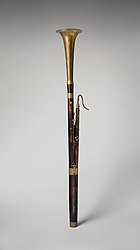Semi-contrabassoon
This article needs additional citations for verification. (July 2024) |
 | |
| Woodwind instrument | |
|---|---|
| Hornbostel–Sachs classification | 422.112–71 (Double-reeded aerophone with keys) |
| Developed | eighteenth century |
| Related instruments | |
The semi-contrabassoon (also called quint bassoon, semi-contra or half-contra) is a double reed woodwind instrument pitched between the bassoon and the contrabassoon. It is pitched in either F (quint bass) or G (quart bass) a fifth or fourth, respectively, below the bassoon.[citation needed] The cantata Nach dir, Herr, verlanget mich, BWV 150, by Johann Sebastian Bach requires a bassoon in A, lower by a minor third than the ordinary bassoon.[1]: 317
History
[edit]These instruments were used mostly in the eighteenth century and are remnants of the old quart bass dulcians.[citation needed] Among the instruments surviving from this period is a semi-contrabassoon made in Leipzig by Johann Heinrich Eichentopf, who was active there from about 1717 until 1749.[2] The organist Charles Marie Widor in his book on orchestration expected that the semi-contra would be added to the orchestra's roster.
The basson-quinte has not yet been made, but bassoon-players are calling for it. It would form the true bass of the Woodwind group, a fifth below the standard instrument, descending consequently to E♭, a semitone lower than the double bass. The low A, which Wagner wrote below B♭ is admirably rich and full; 'then', say professionals, 'why not descend to E♭, with the same fingering and the same capabilities as the ordinary bassoon?' We have already seen that the low fifth, from double B♭ to double F, is sufficiently robust to bear any weight of sound; the "new" low fifth would be still more robust. The basson-quinte is said to be easy of construction; we look to instrument makers to provide us with it in the near future.
— Charles Marie Widor, C. Pierre, La facture instrumentale à l'exposition de 1889.[3]
No instruments were ever constructed on his instigation. Widor's remarks come in light of the dismal state of the French contrabassoon in the late 19th century, which was generally replaced with a contrabass sarrusophone. Arthur Sullivan is said to have owned a semi-contra in F and included parts for it in some of his operettas.[4] Aside from the Great (quart) bass dulcians, the only modern reproductions of historical semi-contras are being made by Guntram Wolf of Germany.[5]
References
[edit]- ^ Curt Sachs (1940). The History of Musical Instruments. New York: W.W. Norton & Company.
- ^ Piero Weiss (2014). Eichentopf, Johann Heinrich. Grove Music Online. Oxford: Oxford University Press. doi:10.1093/gmo/9781561592630.article.L2255565. (subscription required).
- ^ Widor, Charles Marie (2005). Manuel of Practical Orchestration. New York: Dover Publications. p. 47. ISBN 0486442691.
- ^ Langwill, Lyndesay G. (1966). The Bassoon and Contrabassoon. W.W. Norton and Co.
- ^ "Guntram Wolf Modern and Historical Woodwind Instruments". Guntram Wolf.
